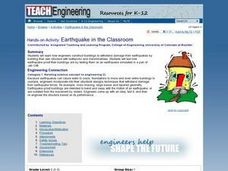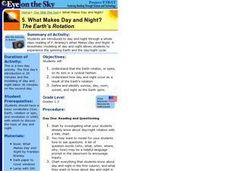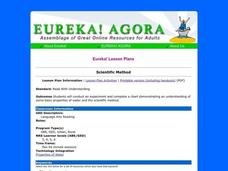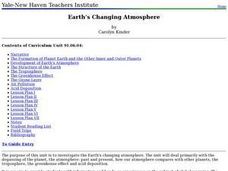Curated OER
Observing Complete Metamorphosis
Sixth graders read about metamorphosis. They observe the metamorphosis of mealworms and set up the tables using Word processing to record their observations as the mealworms went through the stages of metamorphosis.
Curated OER
Earthquake in the Classroom
Pupils discover how engineers construct buildings to stand up against earthquakes. They build their own structures out of marshmallows and toothpicks. They test how earthquake-proof their building is with jello.
Curated OER
The Mystery of the Disappearing Tracks
Fifth graders watch as the teacher projects a series of pictures on the wall showing bird tracks heading toward each other but not meeting, two tracks converging into one, and two tracks converging and then being scuffed up. They write...
Curated OER
Vitamin C Testing
Pupils determine which of three beverage samples contains the most vitamin C. They then apply their knowledge to an additional situation. Students use beverages that have a large, definite difference of vitamin C content to facilitate...
Curated OER
What Makes Day and Night? The Earth's Rotation
Students discover that the Earth rotates on its axis in a cyclical fashion. They examine how this rotation results in day and night.
Curated OER
Footprint Detectives: Making Inferences Using Dinosaur Trackways
Students analyze and discuss footprints and dinosaur tracks. They listen to books about paleontologists, create and analyze their own trackways using black paper and chalk, examine the data, and form hypotheses about footprints and...
Curated OER
American Chestnut
Middle schoolers discuss importance of American Chestnut tree, explore its value and uses, examine how it has almost become extinct, and identify ways certain groups are working to help regain American Chestnut tree population through...
Curated OER
Scientific Method
Students explore the steps in the scientific methods. Through activities, students discover the scientific is a tool for solving problems of any kind. Students will fill out a scientific method chart, and determine what information is...
Curated OER
Bird Beak Adaptation Lab
Young scholars investigate bird beaks to determine which physical adaptations are necessary based on the types of food the birds eat. They participate in a lab by visiting multiple stations to determine which beaks are most efficient,...
Curated OER
The Rotten Truth
Fourth graders watch a video about how much solid waste is produced by each person and how it is disposed of. Using the internet, they identify and interpret data on the type of trash thrown out the most. They offer possible solutions...
Curated OER
What is Wrong with My Pond?
Students examine various pond water samples to identify water quality. For this water quality lesson, students will identify levels of nitrates, ammonia, pH, hardness,and alkalinity in pond water. They will explain importance of water...
Curated OER
Puberty: Day 2
Students investigate human health by researching sexual health facts. In this puberty lesson, students identify the changes that will occur in a teenage body over the next several years and what the eventual outcome will be. Students...
Curated OER
Solar System: Let's Take a Trip
Third graders consider outer space. For this introductory solar system lesson, 3rd graders complete a KWL chart and listen to the story The Magic School Bus: Lost in the Solar System, by Joanna Cole & Bruce Degen. They will...
Curated OER
Can You Find Me Now?
Students locate points using longitude and latitude coordinates. They locate their home using longitude and latitude, explore the uses of GPS, and accurately use a GPS.
Curated OER
Electric Circuits
Students model the flow of electrons in a circuit, draw diagrams of an electric circuit and build an electric circuit. Students explain how to tell when the path of an electric circuit is complete, and test the conductivity of a variety...
Curated OER
Earth's Changing Atmosphere
Students examine the constant changing of the Earth's atmosphere. After labeling the layers of the Earth, they identify various processes inside the Earth that can cause gases to be emitted. Using the internet, they research how the...
Curated OER
Chromatography
Students investigate the separation of mixtures using plant pigments. Using everyday items, they demonstrate the separation of pigments in plants through the process of chromatography.
Curated OER
Visiting Tetra's Web Site on the Internet
Students visit the Tetra-fish web site. They visit a virtual aquarium. Students select their own aquarium and tank size. They select up to twelve different types of tropical fish and read information about their virtual aquarium.
Curated OER
Darwin's Evolution
Students examine the impact of Charles Darwin and his theories on our life today. After watching a video, they discuss how he formulated his theories and how they have impacted the world both positively and negatively. To end the...
Curated OER
Breathe In, Breath Out
Students discover how plants breathe. In this biology lesson plan, students learn that plants take in carbon dioxide and find that plants need sunlight to absorb the carbon dioxide.
Curated OER
Chart the Stars
Seventh graders find constellation distances and plot the stars. For this star lesson, 7th graders plot the star points for Canis Major. Students use graphing calculators to graph the constellation. Students choose another constellation...
Curated OER
Investigating the Soil
Students explore the Earth's crust by researching pH levels and acidity. In this environmental safety lesson, students identify the pros and cons of acidity within soil and how it affects plants. Students collaborate in a pH level...
Curated OER
What's A Pest?
Students examine the common characteristics of household and lawn pests. They discover the life cycles of the pests. They also learn different ways to control the pests.
Curated OER
The Captain And Lake Wilmar
Tenth graders examine the ecosystem of Lake Wilmar through three coordinated performance tasks. They first investigate the effects of pH on freshwater animals by comparing the zooplankton counts from three different areas. They then...























